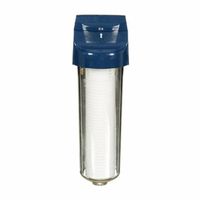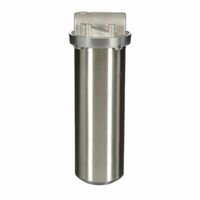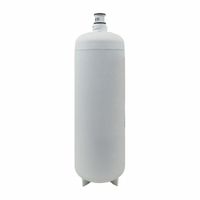Call +(254) 703 030 000 / 751 483 999 / 721 704 777
- Home
- Plumbing
- Water Filtration Purification Systems
- Drinking Water Filter Systems
Frequently Asked Questions
What are the benefits of using a drinking water filter system?
Using a drinking water filter system offers numerous benefits, enhancing both health and convenience. Firstly, it significantly improves water quality by removing contaminants such as chlorine, lead, bacteria, and other harmful substances. This reduction in pollutants not only makes the water safer to drink but also improves its taste and odor, making it more palatable.
Health benefits are paramount, as filtered water reduces the risk of waterborne diseases and exposure to harmful chemicals. By eliminating heavy metals and pathogens, it supports overall well-being and can be particularly beneficial for vulnerable populations like children, the elderly, and those with compromised immune systems.
Economically, a water filter system is cost-effective in the long run. It reduces the need to purchase bottled water, which can be expensive and environmentally damaging due to plastic waste. By investing in a filter system, households can enjoy clean water at a fraction of the cost, contributing to significant savings over time.
Environmentally, using a water filter system is a sustainable choice. It decreases reliance on single-use plastic bottles, thereby reducing plastic pollution and the carbon footprint associated with the production and transportation of bottled water.
Convenience is another advantage, as filtered water is readily available at home, eliminating the need to transport heavy bottles from the store. This accessibility encourages regular hydration, promoting better health.
Additionally, filtered water can enhance the quality of food and beverages prepared at home. Cooking with clean water ensures that the flavors of food and drinks are not compromised by contaminants, leading to better-tasting meals and beverages.
In summary, a drinking water filter system offers improved health, cost savings, environmental benefits, and convenience, making it a valuable addition to any household.
How do I choose the right water filter system for my home?
1. **Identify Water Quality Issues**: Test your water to identify contaminants. Common issues include chlorine, lead, bacteria, sediment, and hard water minerals.
2. **Determine Water Source**: Know if your water comes from a municipal supply or a private well, as this affects the type of filtration needed.
3. **Understand Filtration Types**:
- **Activated Carbon Filters**: Good for removing chlorine, bad tastes, and odors.
- **Reverse Osmosis Systems**: Effective for removing a wide range of contaminants, including heavy metals and dissolved solids.
- **UV Filters**: Best for eliminating bacteria and viruses.
- **Water Softeners**: Ideal for reducing hardness caused by calcium and magnesium.
4. **Consider Installation and Maintenance**: Decide between point-of-use (e.g., under-sink, countertop) and whole-house systems. Evaluate ease of installation and filter replacement frequency.
5. **Evaluate Capacity and Flow Rate**: Ensure the system can handle your household’s water usage and provides adequate flow rate.
6. **Check Certifications**: Look for systems certified by NSF International or the Water Quality Association to ensure effectiveness.
7. **Budget**: Consider initial costs, ongoing maintenance, and filter replacement expenses.
8. **Space and Aesthetic Considerations**: Ensure the system fits your available space and matches your home’s aesthetic if visible.
9. **Read Reviews and Seek Recommendations**: Research user reviews and ask for recommendations from friends or professionals.
10. **Consult a Professional**: If unsure, consult a water treatment professional to assess your needs and recommend suitable options.
What contaminants do water filter systems remove?
Water filter systems are designed to remove a variety of contaminants to ensure safe and clean drinking water. These contaminants include:
1. **Sediments**: Particles like sand, silt, and rust are removed by mechanical filters, which trap these larger particles.
2. **Chlorine and Chloramines**: Activated carbon filters effectively remove chlorine and chloramines, which are commonly used in municipal water treatment but can affect taste and odor.
3. **Volatile Organic Compounds (VOCs)**: These are chemicals that can evaporate into the air and are removed by activated carbon filters. VOCs include industrial solvents and chemicals like benzene and trichloroethylene.
4. **Heavy Metals**: Filters with ion exchange resins or reverse osmosis systems can remove heavy metals such as lead, mercury, and cadmium, which can be harmful even in small amounts.
5. **Microorganisms**: Ultraviolet (UV) filters and reverse osmosis systems can eliminate bacteria, viruses, and protozoa, reducing the risk of waterborne diseases.
6. **Pesticides and Herbicides**: Activated carbon filters can also remove many pesticides and herbicides that may have leached into water supplies from agricultural runoff.
7. **Fluoride**: Some reverse osmosis systems and special activated alumina filters can reduce fluoride levels, which is added to water supplies for dental health but can be controversial.
8. **Nitrates and Nitrites**: These are removed by reverse osmosis systems and ion exchange filters, important for preventing conditions like methemoglobinemia in infants.
9. **Pharmaceuticals**: Trace amounts of pharmaceuticals can be removed by advanced filtration systems, including activated carbon and reverse osmosis.
10. **Total Dissolved Solids (TDS)**: Reverse osmosis systems are effective in reducing TDS, which includes a variety of dissolved ions and minerals.
Different water filter systems target specific contaminants, so it's important to choose a system based on the specific impurities present in your water supply.
How often should I replace the filter in my water filtration system?
The frequency of replacing the filter in your water filtration system depends on several factors, including the type of filter, the quality of your water, and the manufacturer's recommendations. Here are some general guidelines:
1. **Sediment Filters**: Typically, these should be replaced every 6 to 12 months. They are the first line of defense and capture larger particles, so they may need more frequent changes if your water has high sediment levels.
2. **Carbon Filters**: These are common in many systems and should generally be replaced every 6 to 12 months. They remove chlorine, bad tastes, and odors. If your water has a high chlorine content, you might need to replace them more often.
3. **Reverse Osmosis (RO) Membranes**: These usually last 2 to 3 years. However, the pre-filters and post-filters in an RO system should be replaced every 6 to 12 months to protect the membrane.
4. **Ultraviolet (UV) Filters**: The UV lamp should be replaced every 12 months to ensure effective disinfection, even if the lamp still appears to be functioning.
5. **Whole House Filters**: These vary widely based on the system and water quality. Some may need replacement every 3 to 6 months, while others can last up to a year.
6. **Refrigerator Filters**: Typically, these should be replaced every 6 months to ensure clean drinking water and ice.
Always refer to the manufacturer's guidelines for your specific system, as they provide the most accurate recommendations based on the design and capacity of the filter. Additionally, if you notice a decrease in water flow, a change in taste or odor, or if your water quality changes, it may be time to replace the filter sooner.
What is the difference between whole-house and under-sink water filter systems?
Whole-house water filter systems and under-sink water filter systems differ primarily in their scope, installation, and purpose.
Whole-house water filter systems, also known as point-of-entry (POE) systems, are installed at the main water line where water enters the home. This means they filter all the water that flows into the house, providing clean water to every faucet, shower, and appliance. These systems are designed to remove a wide range of contaminants, including sediment, chlorine, and sometimes even heavy metals and bacteria, depending on the specific system. They are ideal for households that want to ensure all water used for drinking, cooking, bathing, and cleaning is filtered. Installation is more complex and typically requires professional assistance. Whole-house systems are generally more expensive due to their comprehensive coverage and capacity.
Under-sink water filter systems, or point-of-use (POU) systems, are installed directly under a specific sink, usually in the kitchen. They filter only the water coming from that particular faucet. These systems are designed to improve the quality of drinking and cooking water by removing contaminants such as chlorine, lead, and other impurities. They are more affordable and easier to install than whole-house systems, often requiring only basic plumbing skills. Under-sink filters are ideal for those who want to ensure clean drinking water without the need to filter water used for other purposes like bathing or laundry.
In summary, the main differences lie in the scope of filtration, installation complexity, and cost, with whole-house systems offering comprehensive filtration for the entire home and under-sink systems providing targeted filtration for specific water sources.
How does reverse osmosis work in water filtration?
Reverse osmosis (RO) is a water filtration process that removes contaminants by using pressure to force water molecules through a semipermeable membrane. The process begins with the application of pressure to the feed water, which contains dissolved solids and impurities. This pressure must exceed the natural osmotic pressure to reverse the natural flow of water, which would typically move from a region of low solute concentration to high solute concentration.
The semipermeable membrane used in RO is designed to allow only water molecules to pass through while blocking larger molecules and ions, such as salts, bacteria, and other impurities. As the pressurized water passes through the membrane, the contaminants are left behind, resulting in purified water on the other side. This purified water is known as the permeate, while the concentrated solution of impurities is referred to as the brine or reject stream.
RO systems typically consist of several stages, including pre-filtration, which removes larger particles and chlorine that could damage the membrane. The main RO process follows, where the semipermeable membrane performs the critical separation. Post-filtration may also be included to further polish the water, removing any remaining tastes or odors.
The efficiency of reverse osmosis depends on factors such as water pressure, temperature, and the concentration of impurities. RO systems are widely used for desalination, producing drinking water from seawater, and in various industrial applications where high-purity water is required. Despite its effectiveness, RO can be energy-intensive and may require regular maintenance to ensure optimal performance and membrane longevity.
Are there any maintenance requirements for water filter systems?
Yes, water filter systems require regular maintenance to ensure optimal performance and longevity. The specific maintenance requirements can vary depending on the type of system, but generally include the following:
1. **Filter Replacement**: Most water filters need periodic replacement. The frequency depends on the type of filter and the manufacturer's recommendations, typically ranging from every few months to annually. Common filters include carbon filters, reverse osmosis membranes, and sediment filters.
2. **Cleaning**: Regular cleaning of the system components, such as housings and tanks, is essential to prevent the buildup of contaminants and bacteria. This may involve disassembling parts of the system and using a mild detergent or a vinegar solution.
3. **System Inspection**: Regularly inspect the system for any signs of wear, leaks, or damage. Check connections, seals, and fittings to ensure they are secure and functioning properly.
4. **Sanitization**: Periodic sanitization of the entire system is recommended to prevent microbial growth. This can be done using a sanitizing solution or bleach, following the manufacturer's instructions.
5. **Pressure Check**: For systems like reverse osmosis, monitoring and maintaining the correct water pressure is crucial. Low pressure can reduce efficiency, while high pressure can damage the system.
6. **Pre-filter Maintenance**: If the system includes pre-filters, these should be checked and replaced as needed to protect the main filter from clogging and to extend its life.
7. **Monitoring Water Quality**: Regularly test the filtered water to ensure it meets safety standards. This can help identify when maintenance is needed or if the system is not functioning correctly.
Adhering to these maintenance practices helps ensure the water filter system operates efficiently, providing clean and safe water. Always refer to the manufacturer's guidelines for specific maintenance instructions.


